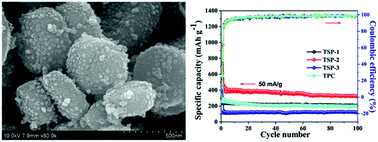TiO2 nanocrystals embedded in sulfur-doped porous carbon as high-performance and long-lasting anode materials for sodium-ion batteries†
Abstract
TiO2 is now developed as a low-cost and high-safety anode material for sodium-ion batteries (SIBs), but its low sodium ion diffusion ability and poor electrical conductivity hinder its sodium-storage performance. In this work, TiO2 nanocrystals embedded in sulfur-doped porous carbon (TSPC) were synthesized through the solvothermal synthesis of a metal–organic framework MIL-125(Ti) precursor and subsequent pyrolysis with inorganic sulfur powder under a nitrogen atmosphere. The inner TiO2 nanocrystals enlarge the electrode/electrolyte interface and shorten the diffusion distance of sodium ions, while the sulfur-doped porous carbon enhances the electron transport ability, inhibits the aggregation of TiO2 nanocrystals, and offers more reaction sites for sodium storage. Benefiting from the synergetic effects between TiO2 nanocrystals and sulfur-doped porous carbon, when used as the anode material for SIBs, the TSPC demonstrates an ultrahigh specific capacity of 323 mA h g−1 after 100 cycles at 50 mA g−1 and extraordinary cycling stability with a capacity retention of 80.1% after 1500 cycles. The TSPC should be a promising anode material for high-performance SIBs.



 Please wait while we load your content...
Please wait while we load your content...